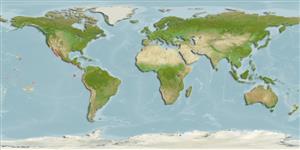>
Blenniiformes (Blennies) >
Labrisomidae (Labrisomids)
Etymology: Labrisomus: Greek, labrax, -akos = a fish, Dicentrarchus labrax+ Greek, soma = body (Ref. 45335).
Environment: milieu / climate zone / depth range / distribution range
Écologie
marin récifal; profondeur 0 - 5 m (Ref. 55763). Tropical
Eastern Pacific: Bahía Sebastián Vizcaino and the upper Gulf of California to Peru, including the Galapagos Islands.
Taille / Poids / Âge
Maturity: Lm ? range ? - ? cm
Max length : 18.0 cm TL mâle / non sexé; (Ref. 55763); common length : 10.0 cm TL mâle / non sexé; (Ref. 55763)
Description synthétique
Clés d'identification | Morphologie | Morphométrie
Body small and elongate; head with a large number of sensorial pores; dorsal fin with 17 to 19 spines and 11 to 13 soft rays (XVII-XIX, 11-13); anal fin with 2 spines and 17 to 18 soft rays (II, 17-18); lateral line scales 65 to 69; body brownish, with dark blotches on the flanks and a pair of oblique, brown spots on the cheeks; dorsal, pectoral and caudal fins with scattered dark spots (Ref. 55763).
Life cycle and mating behavior
Maturité | Reproduction | Frai | Œufs | Fécondité | Larves
Thomson, D.A., 1987. Reef fishes of the Sea of Cortez. The rocky-shore fishes of the Gulf of California. The University of Arizona Press, Tucson. 302 p. (Ref. 5592)
Statut dans la liste rouge de l'IUCN (Ref. 130435: Version 2024-2)
Menace pour l'homme
Harmless
Utilisations par l'homme
Outils
Articles particuliers
Télécharger en XML
Sources Internet
Estimates based on models
Preferred temperature (Ref.
123201): 19.8 - 28.9, mean 24 °C (based on 223 cells).
Phylogenetic diversity index (Ref.
82804): PD
50 = 0.5005 [Uniqueness, from 0.5 = low to 2.0 = high].
Bayesian length-weight: a=0.00955 (0.00474 - 0.01922), b=3.10 (2.93 - 3.27), in cm total length, based on LWR estimates for this species & (Sub)family-body (Ref.
93245).
Niveau trophique (Ref.
69278): 3.5 ±0.3 se; based on size and trophs of closest relatives
Fishing Vulnerability (Ref.
59153): Low vulnerability (10 of 100).
Nutrients (Ref.
124155): Calcium = 88.4 [52.5, 147.5] mg/100g; Iron = 0.729 [0.436, 1.194] mg/100g; Protein = 19.1 [18.0, 20.1] %; Omega3 = 0.124 [0.077, 0.197] g/100g; Selenium = 18.9 [10.1, 35.1] μg/100g; VitaminA = 117 [40, 339] μg/100g; Zinc = 1.75 [1.21, 2.44] mg/100g (wet weight);
